We believe in the importance of empowering customers to feel more comfortable in conversations about the products being used in production lines. Pricing and recommendations are heavily based on meeting the spec of the job, but if everything about the product is confusing that can make it hard to understand why certain materials are being recommended over others. Not to mention understanding why one material might not work over another even if they seem similar. We offer stock and custom bags and can have most stock to you within 2-3 days. Custom printing, specialty gusseted options, UVI or anti-stat, and many more options are available. The following is a quick but detailed breakdown of the most common characteristics of poly bags available in the marketplace.
Understanding the Differences Between Bag Materials
Low Density Polyethylene (LDPE – also simply known as “poly”)
This is probably the most common type of bag. An example of LDPE bags would be your standard sandwich bags you buy at the grocery store. It is flexible and tough, but is breakable, and comes in a variety of thicknesses and sizes. Most LDPE bags are USDA and FDA approved for food storage. Polyethylene is translucent and prohibits a greater amount of light from penetrating, subsequently making it the preferred choice for archival storage of printed materials. It has a low static charge, meaning that it will attract less dirt, dust or other foreign elements than other materials.
Linear Low Density Polyethylene (LLDPE)
Similar in appearance and feel to LDPE, LLDPE is a stronger variant of a polyethylene bag. It has more puncture resistance and resilience than LDPE, is very flexible and stretchy, offers better resistance to heat and cold, all while not needing to be as thick as a comparable strength LDPE bag. It is not as easy to process as LDPE and can therefore be more expensive, has a lower gloss, and a narrower range for heat sealing.
High Density Polyethylene (HDPE)
HDPE is most commonly seen in retail bags like you get at the grocery or drug store, or in trash can liners. It has very little clarity and is thinner and very “crinkly” compared to LDPE (standard poly) which is smoother and has very good clarity. The advantage of HDPE is its high strength to density ratio – meaning that it can be very strong while still being very thin. It has less flexibility than LDPE and can withstand higher temperatures for short periods.
Polypropylene (polypro or LDPP)
This is most common for food products and for presentation quality. It is a high clarity bag that provides a protective barrier against moisture and vapors, which helps delay evaporation and dehydration to preserve freshness and taste of food products. It is fully transparent. They are ideal for food storage, clean room, electronics, and other applications. It is stiffer and more “crinkly” than LDPE and has a slightly rougher surface. It is not flexible or tear/puncture resistant. All polypro bags meet FDA and USDA specifications.
| Polyethylene | Polypropylene | |
| Clarity | Good (decreasing with thickness) | Excellent |
| Translucent (prohibits more light) | Transparent | |
| FDA/USDA Approved | Yes | Yes |
| Heat Sealable | Yes | Yes |
| Flexible | Yes | No |
| Puncture Resistance | Good (depending upon thickness) | Fair |
| Food Storage | Good | Excellent |
| Stock Thicknesses | 1 mil – 6mil | .8mil – 3mil (1.5mil standard) |
| Archival Storage | Excellent | Good |
| Surface Texture | Smooth | Rough (relatively) |
| Static Charge | Low | Higher |
| Chemical Resistance | Good | Excellent |
| Melting Point | Low | High |
Finding the right bag for your application
Now that you know what the bags are made of, now it’s time for our best recommendations based off your needs. We always recommend lending your supplier some samples of what you currently use, requesting samples of your own for testing, and explaining your application to your packaging specialist to guarantee the correct bag is being used.
| Strength and resistance to tear/puncture | LLDPE, LDPE |
| Clarity and presentation | PolyPro |
| Flexibility and toughness | LDPE or LLDPE |
| Strength and affordability | HDPE |
| Food storage (long term) | PolyPro |
| Food storage (short term) | LDPE or PolyPro |
| Can/Bin liners | HDPE or LDPE |
| Retail merchandise bags | HDPE or LDPE |
| Affordability, effectiveness, and diversity of applications | LDPE |
| FDA/USDA approval | LDPE or PolyPro |
| Archival storage of printed materials | LDPE |
| Heat sealing | LDPE & LLDPE are ideal and most common. Others are dependent upon the machine and bag thickness |
The thickness (mil) of bags makes a difference
Similar to other packaging products like stretch film or tape, the thickness of your bag highly determines its effectiveness (and price). Mil thickness generally ranges from 1 mil to 6 mil and what you use is determined by what is going into the bag, how it is being shipped, and the weight of the object. Depending on if or how you are sealing the bag the thickness can also change. Heavier, pointier objects are going to need a thicker bag to help with puncture resistance whereas an object without sharp corners will not. If heat sealing the bag a certain thickness might be in order to guarantee a proper seal.
Sealing Bags
Heat Sealing
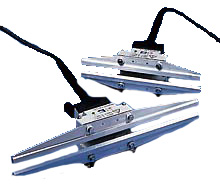 Heat sealers offer a secure seal for polyethylene and polypropylene bags up to 6mil thick and up to 24” wide. Many heat sealers come with a warranty program, require no warm-up period, and use electricity only when the sealing bar is down. Options include hand sealers, manual foot-operated sealers, and automatic sealers, with or without trimmers. Each heat sealer creates a seal that is both water-tight and air-tight. Using a heat sealer creates a permanent seal that cannot be reused.
Heat sealers offer a secure seal for polyethylene and polypropylene bags up to 6mil thick and up to 24” wide. Many heat sealers come with a warranty program, require no warm-up period, and use electricity only when the sealing bar is down. Options include hand sealers, manual foot-operated sealers, and automatic sealers, with or without trimmers. Each heat sealer creates a seal that is both water-tight and air-tight. Using a heat sealer creates a permanent seal that cannot be reused.
Reclosable/Zip Top Bags
Reclosable zip-top bags are lay flat or bottom-gusseted and range in thickness from 1mil to 6mil. Most zip top bags are FDA approved and offered in polyethylene or polypropylene. There are generally three types of zip top reclosable bags:
- Standard Single-Track Reclosable Zip Tops
These offer a standard single zipper closure, similar to retail zip top sandwich bags - Double-Track Reclosable Zip Tops
These bags offer a double-zip closure that assures an extra-secure seal - Slider Top Reclosable Zip Tops
Slider top bags are ideal for bags that need to be accessed repeatedly. They are easy to use and access, even with gloved hands. The slider assures as much as possible that the seal is complete and secure.
Lip and Tape Closures
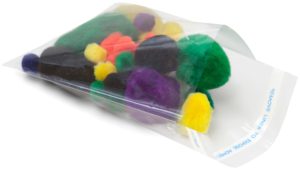
A lip and tape closure is similar to an envelope closure where there is a lip that extends over the opening of the bag and which has a tape strip that, when folded down to the bag, creates a seal. Lip and tape closures can be permanent or reusable.
Draw String Closure
Double-pull drawstring bags open easily and provide a secure closure as well as a convenient means of hanging the bag. They can be reused multiple times. They are ideal for content that needs to be accessed repeatedly and easily and in a way that will eliminate fall-out possibility.
Ties and Tape
Common options include vinyl and paper twist ties as well as nylon cable ties, self-locking adjustable plastic ties, and bag sealing tape. Each of these offers an easy and affordable means of sealing any type of bag. Of these, only the nylon cable ties and the bag sealing tape are not reusable.
Bags and Tubing best suited for sensitive electrical components
Metallic Static Shielding Bags
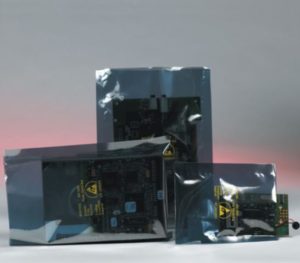 Best for static sensitive components that are handled outside of an Electrostatic Protected Area (EPA). These form an effective Faraday Cage around the contents (a Faraday Cage is when the bag is slightly conductive and forms a shield around the contents to protect any discharges from being deposited on to the protected device during the handling process). These bags should not be creased or used if there are any tears or punctures as it can reduce the integrity of the shield/Faraday Cage. The effectiveness of the bag can also deteriorate with use, so when in doubt, it is best to use new bags. Make sure your static shielding bags meet certain electrical and physical requirements like ANSI/ESD S541, EIA 625 and ANSI/ESD S20.20 program compliant, and/or tested per MIL-STD3010 4046 and ANSI/ESD STM11.11.
Best for static sensitive components that are handled outside of an Electrostatic Protected Area (EPA). These form an effective Faraday Cage around the contents (a Faraday Cage is when the bag is slightly conductive and forms a shield around the contents to protect any discharges from being deposited on to the protected device during the handling process). These bags should not be creased or used if there are any tears or punctures as it can reduce the integrity of the shield/Faraday Cage. The effectiveness of the bag can also deteriorate with use, so when in doubt, it is best to use new bags. Make sure your static shielding bags meet certain electrical and physical requirements like ANSI/ESD S541, EIA 625 and ANSI/ESD S20.20 program compliant, and/or tested per MIL-STD3010 4046 and ANSI/ESD STM11.11.
Black Conductive Bags
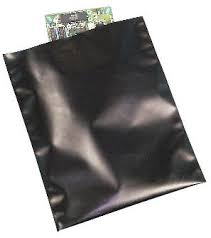 These bags should only be used in an Electrostatic Protected Area (EPA) and while the handler is grounded. It is possible that contents could be damaged by contact with an electrostatic discharge (ESD – an uncontrolled surge of static between objects with different voltage).
These bags should only be used in an Electrostatic Protected Area (EPA) and while the handler is grounded. It is possible that contents could be damaged by contact with an electrostatic discharge (ESD – an uncontrolled surge of static between objects with different voltage).
Check to see if black conductive bags meet the requirements of MIL-P-82646 Rev B
Pink Anti-Static (PAS) Bags
PAS bags are the only acceptable poly bag in an electrostatic protected area and offer no effective protection against a contact electrostatic discharge. They are best used for non-static sensitive components, such as nuts and bolts. Standard poly bags may generate and hold static charges 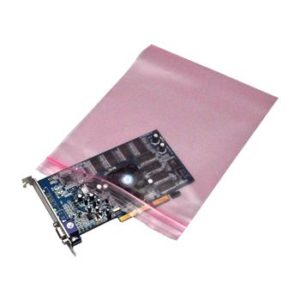 greater than 10,000v, making the PAS bags a highly practical option. PAS bags are also amine-free. The effectiveness of anti-static bags can deteriorate over time, so when in doubt, it is best to use new bags.
greater than 10,000v, making the PAS bags a highly practical option. PAS bags are also amine-free. The effectiveness of anti-static bags can deteriorate over time, so when in doubt, it is best to use new bags.
Ask if PAS bags meet the static decay requirements of MIL-PRF-81705E, Type II and EIA-541 and/or bags ags 4mil and thicker are engineered to provide a surface resistivity less than 1×1012 ohms/sq.
Looking for more information for application-specific options? Contact us! We work with customers on many bag-specific projects from lining gaylords for better containment to kitting for faster shipping. We will work side-by-side on making sure the bag being recommended works for your project and budget. Browse some of our most popular options here!




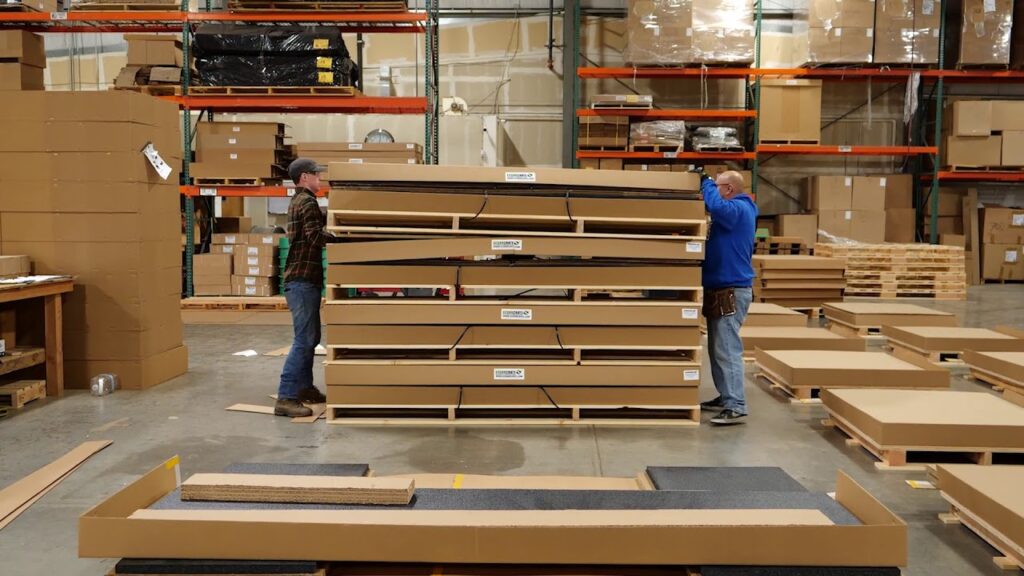
Comments are closed.